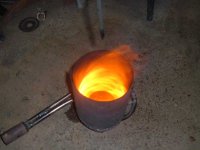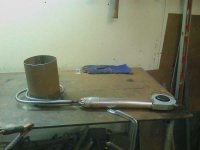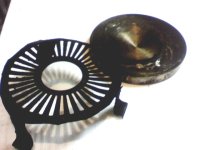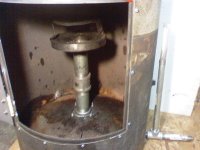LetsRoll
Gold Member
The conical is needed for heat, not for holding the starter fuel. Be it kerosene, diesel, gas or even carburator cleaner, maybe even ether. When you use a fuel that is explosive like gas, use very little. Like a tea spoon full. Tea spoon full should be enough to get the fire going. Put in a little oil, like a tea spoon full. Take your finger and spread the oil out over your burn area. Pour the tea spoon full of gas over your burner and spread it out as well. Then light the oil and gas and close the door (have all vents closed) and turn the oil on and start the air induction. Once the inside pressure equals out (air pressure exits the flue pipe), open the vents and adjust oil and air pressure to desired amount of heat. Which should be the hot burn. Haveing all of the vents closed is because the air pressure will exit the stove through the air vents, not the flue pipe. And first starting the stove is when its hard to get the fuel and air ratio right. If its not right, it will smoke real bad and the air will push the smoke out the air vents (been there and done it). This is why the vents have to be closed. When there closed, the air will push the smoke out the flue pipe. The conical is needed cause as it turns red (hot), the oil that is not burnt by the flame, the conical will get it. When I was testing my hot burn, I had the oil flow rolling. Some of the oil mist was not getting burnt before it hit the conical. Once it hit the conical, the oil blew up and was burnt. That sounds kind of funny, but it was happening. What that told me was, I didn't have enough air pressure being inducted into the path of the dripping oil. The air stream was not turning the oil into a mist. Once I turned up the pressure, all of the oil was being burnt before it hit the conical. And the flame was really clear. This was how I was able to see the conical. Which is terms is a clean burn. I was able to do this during low burn, medium burn and a hot burn.Donman said:Nice job! It appears to me that the only reason you need a conical is for the initial start up - something to hold the kerosene while it heats up.
To be truthful with you, I dont see how his setup (liquid vaporization method) is working like the article is claiming. I tried his method and I could not get the conical hot enough to vaporize the oil and have a clean burn. I tried several test. I was able to get a good flame rolling, but not hot enough to completely burn all of the oil. I had soot rolling out of the exhaust pipe like a tractor trailor taking off from a stop. One thing that is different, that I know of is, his stove diameter is smaller than my stove diameter. My inside stove area is awhole lot larger than his is. I do know that, the more you compress the flame, the hotter it will be. Another thing is, his steel is awhole lot thinner than mine. Water heater skin is probably 1/16 inch thick. My stove skin is 3/8 inch thick. It takes a lot of heat to heat 3/8 inch thick steel up. Heating 1/16 inch steel probably aided in heating his stove better than mine. But I still can't see how he's getting a clean burn like the article is claiming.Donman said:If the conical gets fire red hot there is most likely no liquid in it at all during most of the burn. The main reason Roger Sanders used the conical was for liquid vaporization which kept the hard deposits out with his drip feed method. It looks like you are getting a nice clean burn and variable heat with your design.
Just thinking out load here, since a hot water heater is tall and he has a 4 inch round tube ran down through it to the conical and a round 2 inch inside diameter washer on top of the round tube acting as a restrictor. And the oil line runs down the round tube. As the flame is burning and sucking in air, maybe its makeing a air induction affect on the flame. Maybe this is how he's getting a clean burn. The round tube is acting like a air induction as the flame is sucking in air. Turn the oil up, more oil is being burnt, the flame is bigger, the flame is sucking harder. Hmmm....I just wonder if this is what is actually whats happening. If so, I went the wrong way. Ok, this is going to eat me up until I find out. I just might try it. I have an old water heater setting in my shop. I just might give it a try when I finish mine.



